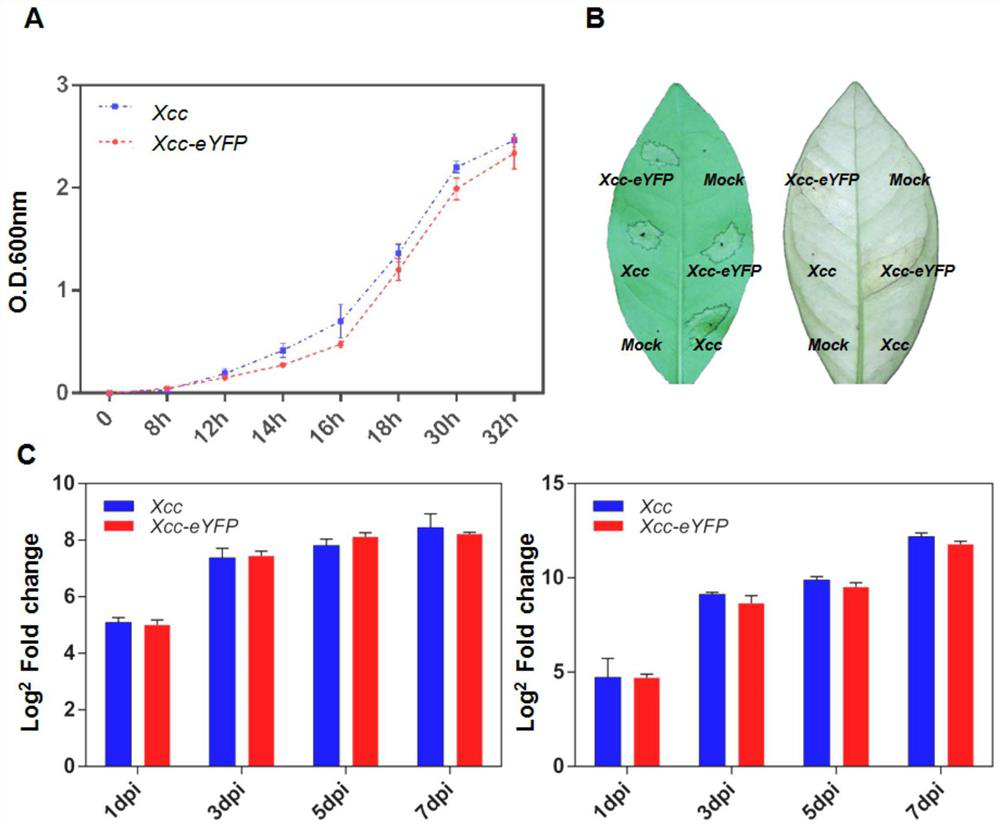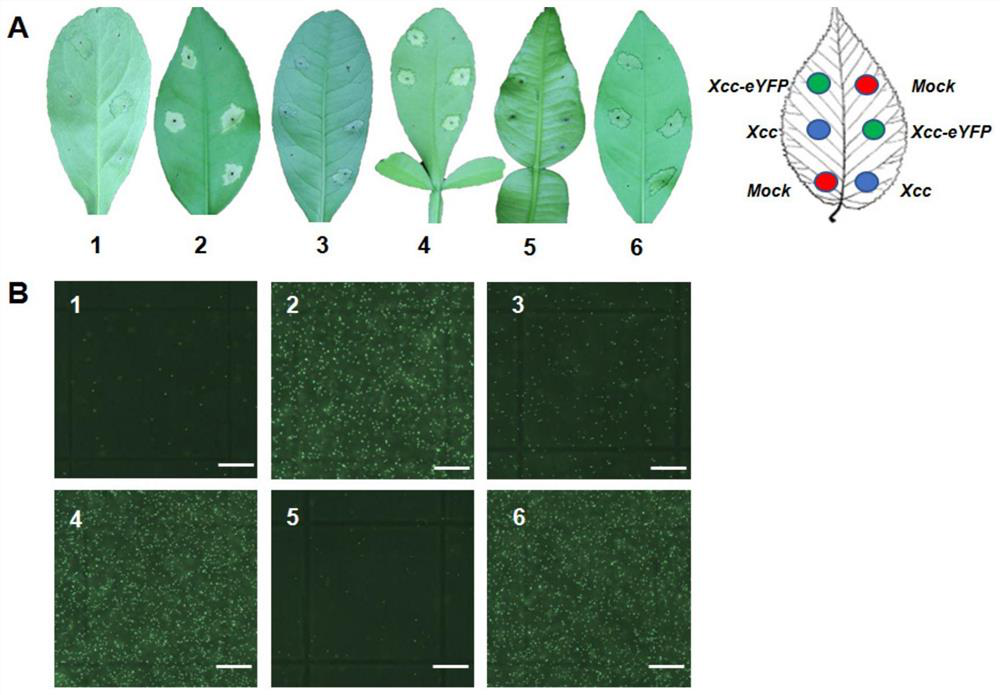Method for rapidly evaluating canker resistance of citrus variety
A technology for citrus and varieties, applied in the field of rapid assessment of citrus varieties' resistance to canker disease, can solve time-consuming and labor-intensive problems, reduce costs and labor, and improve resistance
- Summary
- Abstract
- Description
- Claims
- Application Information
AI Technical Summary
Problems solved by technology
Method used
Image
Examples
Embodiment 1
[0038] The construction of embodiment 1 enhanced yellow-green fluorescent protein (eYFP) plasmid and Xcc-eYFP strain
[0039] 1. Method
[0040] The eYFP coding region (SEQ ID NO.1):
[0041] atggtgagcaagggcgaggagctgttcaccggggtggtgcccatcctggtcgagctggacggcgacgtaaacggccacaagttcagcgtgtccggcgagggcgagggcgatgccacctacggcaagctgaccctgaagttcatctgcaccaccggcaagctgcccgtgccctggcccaccctcgtgaccaccttcggctacggcctgcagtgcttcgcccgctaccccgaccacatgaagcagcacgacttcttcaagtccgccatgcccgaaggctacgtccaggagcgcaccatcttcttcaaggacgacggcaactacaagacccgcgccgaggtgaagttcgagggcgacaccctggtgaaccgcatcgagctgaagggcatcgacttcaaggaggacggcaacatcctggggcacaagctggagtacaactacaacagccacaacgtctatatcatggccgacaagcagaagaacggcatcaaggtgaacttcaagatccgccacaacatcgaggacggcagcgtgcagctcgccgaccactaccagcagaacacccccatcggcgacggccccgtgctgctgcccgacaaccactacctgagctaccagtccgccctgagcaaagaccccaacgagaagcgcgatcacatggtcctgctggagttcgtgaccgccgccgggatcactctcggcatggacgagctgtacaagtga;克隆到pBBR1-MCS5质粒中,构建了广域宿主的载体pBBR1-eYFP。 The recombinant plasmid of pBBR1-eYFP w...
Embodiment 2
[0045] The comparison of embodiment 2 routine and fluorescent spot counting method measuring Xcc
[0046] Using plate dilution counting method on the culture medium is a common method to determine the amount of bacterial growth, but this method is time-consuming and laborious. The purpose of the present invention is to simplify and speed up the quantification of Xcc by counting the fluorescence amount of Xcc-eYFP using a fluorescence microscope. To verify the accuracy of the method, we quantified Xcc-eYFP extracted from infected leaves by conventional electroplating and fluorescent spot counting methods. Xcc-eYFP was extracted from inoculated Hamlin sweet orange leaves at 1, 3, 5, 7, and 9 days post-inoculation (dpi). Both methods observed similar bacterial concentrations of Xcc-eYFP at all time points (e.g. Figure 4 Shown), indicating that the accuracy of the fluorescent spot counting method is consistent with the traditional plate colony counting method. Secondly, the st...
Embodiment 3
[0047] Example 3 Using Xcc-eYFP to assess the susceptibility of citrus varieties to canker
[0048] Set the concentration to 5 x 10 8 cfu / mL of Xcc-eYFP and Xcc were inoculated on 20 citrus varieties, including 18 wild citrus accessions (Table 1). Similar symptoms were observed on citrus varieties inoculated with Xcc-eYFP and Xcc (eg Figure 5 shown). Among the 20 citrus varieties, Dali citron, Yiliang citron, Yichang orange, Huapi kumquat, Longyan kumquat, Bawang kumquat and Daoxian wild orange showed no or significantly reduced ulcer symptoms. On the contrary, Pingbian wild sweet orange, Jianshui orange, Longmen lemon, Chongyi wild orange, Mangshan wild orange, Jiangjin lime, Kalizuo orange, Ledong kumquat, wasp orange, Honghe orange, Mengla sour pomelo Hechenggu wild pomelo showed typical ulcer disease symptoms.
[0049] According to the growth of Xcc-eYFP and Xcc in plants, the bacterial concentrations in Dali citron, Yiliang citron, Yichang orange, Huapi kumquat and B...
PUM
 Login to View More
Login to View More Abstract
Description
Claims
Application Information
 Login to View More
Login to View More - R&D
- Intellectual Property
- Life Sciences
- Materials
- Tech Scout
- Unparalleled Data Quality
- Higher Quality Content
- 60% Fewer Hallucinations
Browse by: Latest US Patents, China's latest patents, Technical Efficacy Thesaurus, Application Domain, Technology Topic, Popular Technical Reports.
© 2025 PatSnap. All rights reserved.Legal|Privacy policy|Modern Slavery Act Transparency Statement|Sitemap|About US| Contact US: help@patsnap.com



